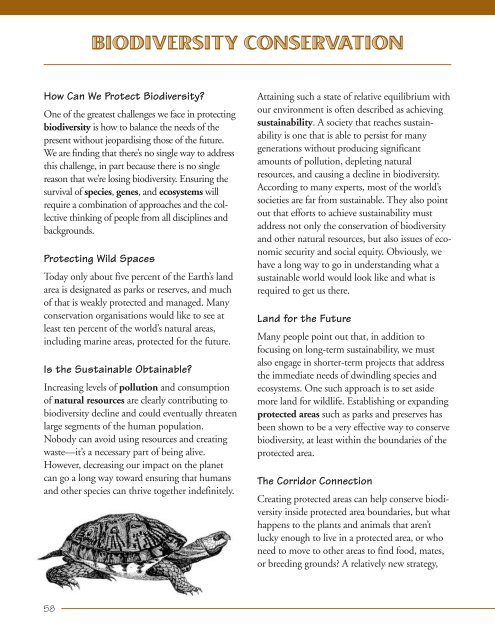EXPLORING BIODIVERSITY: A Guide for Educators Around the World
EXPLORING BIODIVERSITY: A Guide for Educators Around the World
EXPLORING BIODIVERSITY: A Guide for Educators Around the World
You also want an ePaper? Increase the reach of your titles
YUMPU automatically turns print PDFs into web optimized ePapers that Google loves.
<strong>BIODIVERSITY</strong> CONSERVATION<br />
How Can We Protect Biodiversity?<br />
One of <strong>the</strong> greatest challenges we face in protecting<br />
biodiversity is how to balance <strong>the</strong> needs of <strong>the</strong><br />
present without jeopardising those of <strong>the</strong> future.<br />
We are finding that <strong>the</strong>re’s no single way to address<br />
this challenge, in part because <strong>the</strong>re is no single<br />
reason that we’re losing biodiversity. Ensuring <strong>the</strong><br />
survival of species, genes, and ecosystems will<br />
require a combination of approaches and <strong>the</strong> collective<br />
thinking of people from all disciplines and<br />
backgrounds.<br />
Protecting Wild Spaces<br />
Today only about five percent of <strong>the</strong> Earth’s land<br />
area is designated as parks or reserves, and much<br />
of that is weakly protected and managed. Many<br />
conservation organisations would like to see at<br />
least ten percent of <strong>the</strong> world’s natural areas,<br />
including marine areas, protected <strong>for</strong> <strong>the</strong> future.<br />
Is <strong>the</strong> Sustainable Obtainable?<br />
Increasing levels of pollution and consumption<br />
of natural resources are clearly contributing to<br />
biodiversity decline and could eventually threaten<br />
large segments of <strong>the</strong> human population.<br />
Nobody can avoid using resources and creating<br />
waste—it’s a necessary part of being alive.<br />
However, decreasing our impact on <strong>the</strong> planet<br />
can go a long way toward ensuring that humans<br />
and o<strong>the</strong>r species can thrive toge<strong>the</strong>r indefinitely.<br />
Attaining such a state of relative equilibrium with<br />
our environment is often described as achieving<br />
sustainability. A society that reaches sustainability<br />
is one that is able to persist <strong>for</strong> many<br />
generations without producing significant<br />
amounts of pollution, depleting natural<br />
resources, and causing a decline in biodiversity.<br />
According to many experts, most of <strong>the</strong> world’s<br />
societies are far from sustainable. They also point<br />
out that ef<strong>for</strong>ts to achieve sustainability must<br />
address not only <strong>the</strong> conservation of biodiversity<br />
and o<strong>the</strong>r natural resources, but also issues of economic<br />
security and social equity. Obviously, we<br />
have a long way to go in understanding what a<br />
sustainable world would look like and what is<br />
required to get us <strong>the</strong>re.<br />
Land <strong>for</strong> <strong>the</strong> Future<br />
Many people point out that, in addition to<br />
focusing on long-term sustainability, we must<br />
also engage in shorter-term projects that address<br />
<strong>the</strong> immediate needs of dwindling species and<br />
ecosystems. One such approach is to set aside<br />
more land <strong>for</strong> wildlife. Establishing or expanding<br />
protected areas such as parks and preserves has<br />
been shown to be a very effective way to conserve<br />
biodiversity, at least within <strong>the</strong> boundaries of <strong>the</strong><br />
protected area.<br />
The Corridor Connection<br />
Creating protected areas can help conserve biodiversity<br />
inside protected area boundaries, but what<br />
happens to <strong>the</strong> plants and animals that aren’t<br />
lucky enough to live in a protected area, or who<br />
need to move to o<strong>the</strong>r areas to find food, mates,<br />
or breeding grounds? A relatively new strategy,<br />
58

















